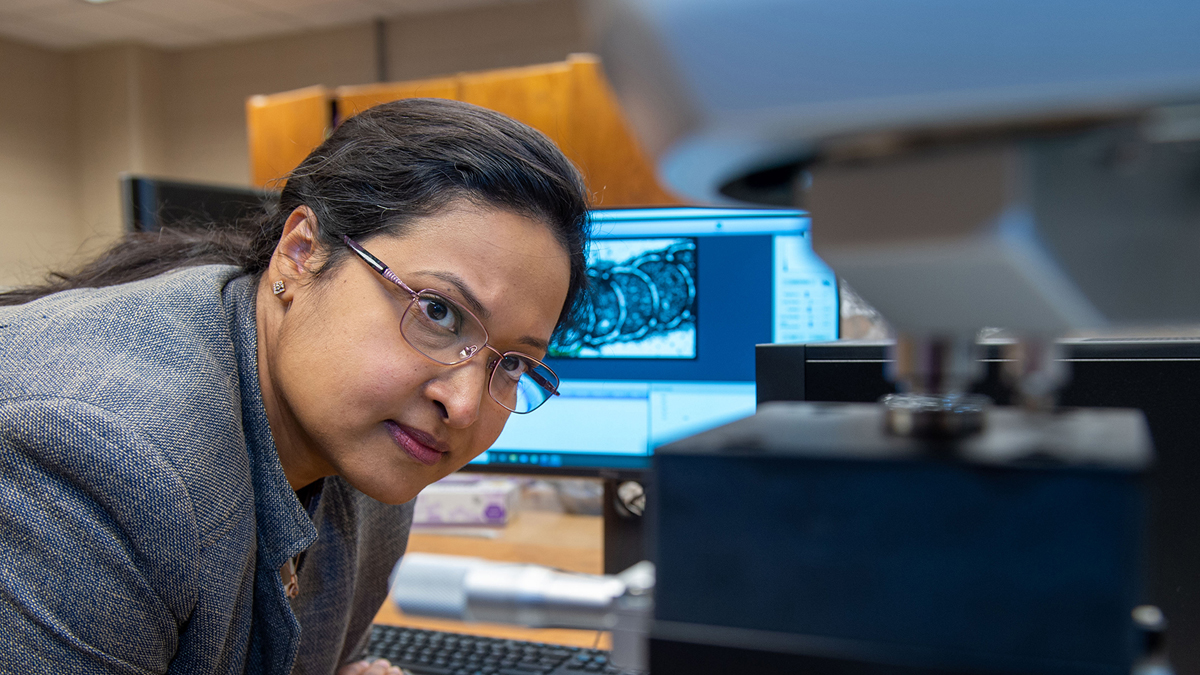
Sabrina Nilufar, assistant professor in the SIU School of Mechanical, Aerospace, and Materials Engineering, is working on ways to more easily and efficiently construct so-called “sandwich” materials used in everything from automotive to marine and aerospace applications. She recently received a two-year, $200,000 grant from the National Science Foundation to study how to make specially designed structures built using additive manufacturing, one of the fastest emerging engineering research areas in the world. (Photo by Russell Bailey)
April 04, 2022
SIU researcher seeks more efficient ways to make stronger structural materials
CARBONDALE, Ill. – Sabrina Nilufar’s research involves sandwiches, but not the kind you eat.
Instead, the Southern Illinois University Carbondale researcher hopes to improve the ultra-strong “sandwich” materials hidden within the sleek, smooth and shiny car panels and airplane wings that we trust with our lives.
An assistant professor in the SIU School of Mechanical, Aerospace, and Materials Engineering, Nilufar is working on ways to more easily construct these ubiquitous materials, improving efficiency while saving time and energy. She recently received a two-year, $200,000 grant from the National Science Foundation to study how to make specially designed structures built using additive manufacturing, one of the fastest emerging engineering research areas in the world.
Hidden in plain site
Sandwich structures generally consist of two outer face sheets separated by a lightweight, low-density core structure or foam. The engineering concept has found its way into a myriad of applications, including aerospace, sport, marine, military, thermal insulation, vibration and acoustic isolation, and automotive parts.
The traditional manufacturing process for sandwich materials, however, can be wasteful and limited. In contrast, additive manufacturing allows builders to fabricate objects or custom tailor parts with complex geometry directly from the 3D models to meet specific applications.
The additive manufacturing process may hold the key to both increased efficiency and better-quality parts, especially when combined with triply periodic minimal surface (TPMS) architecture. TPMS architecture uses complex geometries found in nature to improve strength and weight ratios.
“The aim of my research is to set a solid foundation of manufacturing sandwiches with TPMS-based core lattice for specific engineering applications,” Nilufar said.
Sandwich, anyone?
Although sandwich structures are used in many manufacturing processes, the main limiting factor lies in what’s between the face sheets, which act as the “bread.” The topology of the sandwich’s middle, or core, has a major impact on the overall performance of the structure, in terms of weight, strength, thermal properties and other factors.
Depending on the core’s geometry, such factors can be improved or diminished in function. Engineers theorize about new core structures but at this point know little because of limitations in the manufacturing process.
Working in her laboratory at SIU, Nilufar hopes to reveal the mechanisms and thermomechanical properties of various core structures that can be created with TPMS architecture. Her approach will integrate numerical and experimental methods to find out what manufacturers might achieve using additive processes.
“We want to fundamentally understand how structured core lattice architecture improves the mechanical and thermal properties of sandwich structures,” Nilufar said.
A new way of approaching it
Additive manufacturing refers to creating an object one layer at a time, usually using a 3D printing process, which can deliver highly complex or even combination parts with added strength. Common applications include building ducts for environmental control systems, custom cosmetic aircraft interior components and rocket engine components, among others.
Engineers say additive manufacturing offers many advantages, including a relatively low cost for acquiring the equipment, less material waste, improved energy efficiency and easier inventory management. The process also makes it easier to do short runs of rarely needed parts, or to create hard-to-find legacy parts for older machines.
Focusing on TPMS
Nilufar will focus heavily on investigating TPMS architecture, particularly on core lattice geometries, such as gyroid, diamond, and primitive core structures.
As part of the effort, her research team will develop 3D models to predict thermomechanical properties for various core topologies. The work will identify high-stress and critical sections of various structures and look at how to optimize factors such as the size of each cell and wall thickness.
The team also will examine how and why TPMS structures deform under various loads and temperatures. Along those lines, Nilufar and others will use an electron microscope to look closely at surface morphology and failure mechanisms.
“We hope the project helps us gain new understandings of how these forces would impact TPMS structures in the real world,” Nilufar said.
Multiple benefits
Nilufar’s work will involve multiple disciplines, including engineering mechanics, materials science and additive manufacturing. The grant will support the research of both graduate and undergraduate students – a key feature of SIU’s student experience – and encourage participation by underrepresented minorities in science and engineering.
Refining new manufacturing processes through research like Nilufar’s would benefit the national economy. And the local outreach component of the project will demonstrate research concepts to high school and middle school students, planting the seeds for future engineers.
